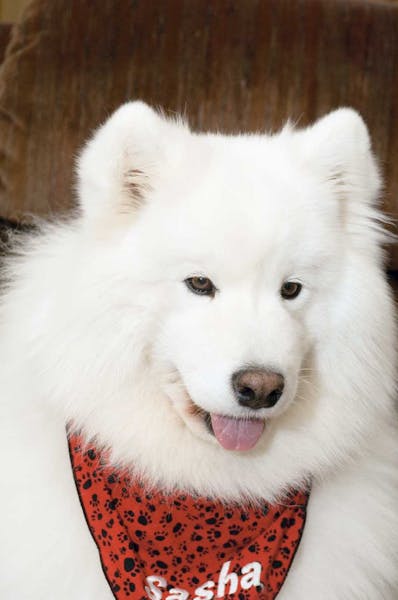Chopper's a busy guy. During summer school, you may find him lying on a blanket in Pat Kinch's classroom while a child reads to him. Or the 4-year-old rottweiler might be at Abbott Northwestern calming the nerves of a child undergoing radiation treatments for cancer. Once a week, he's at summer camp with autistic kids, encouraging their verbal skills. And he makes regular visits to nursing homes, where he interacts with seniors.
Chopper loves his job
For Chopper, this isn't play, it's work. But he absolutely loves his job. And so does his owner, Kinch, an Eden Prairie schoolteacher from St. Michael. "Some dogs need to have a job. They're healthier and happier," Kinch says. Both she and Chopper benefit from the close bond they've formed through his work as a therapy dog. In recognition of Chopper's community service, especially his work with children who have cancer, Chopper was inducted into the Animal Hall of Fame sponsored by the Minnesota Veterinary Medical Association.
With his "bomb-proof" temperament, ability to interact with strangers, intelligence and willingness to learn, Chopper makes an ideal therapy dog.
You and your dog's temperaments count
Kinch, who also teaches therapy training classes through Elk River K9 Training Center, says you can tell a good therapy dog candidate while still in its litter. "Look for the puppy that's outgoing with humans, that comes to you and craves attention. One that has a stable temperament. You're looking for the `middle' dog - not the most dominant or the most submissive."
Pals on Paws, the local chapter of Therapy Dogs International, offers an online checklist for determining if your adult dog has potential for therapy work. Among the questions are:
- Is your dog both calm and friendly?
- How does he react to strangers on the street and in your home?
- Does your dog take unusual sights and sounds in stride?
- Does your dog have basic good manners?
- What is your dog's true personality?
The list has some questions for you, too: Do you enjoy visiting healthcare/educational facilities? Do you enjoy meeting strangers and making conversation with them? Are you comfortable interacting with children and elderly who may be physically ill or mentally challenged? Do you have the time?
Basic obedience and therapy certification
While your dog may have the innate personality to be a therapy dog, he must also be well trained. Kinch says basic obedience builds a strong foundation and allows your dog to be successful in therapy work.
Once your dog has mastered basic obedience skills, Kinch recommends taking a class where participants can practice and strengthen "therapy" skills. "We go over how to do a visit - things like how to approach people in chairs or beds," Kinch says. "We also touch the dogs' ears and feet, hug them, pet them in a variety of ways and even put our hands in their mouths. We also work on avoiding distractions on the floor and train the dogs with a `Leave it!' command."
Therapy Dogs International, Inc., the organization that regulates, tests and registers therapy dogs and their handlers, conducts a 13-part certification test that includes: accepting a friendly stranger, sitting politely for petting, walking through a crowd, sitting and staying on command, coming when called, supervised separation, reaction to other dogs and distractions, and willingness to "visit" people of all ages.
Pit bull makes nursing home rounds
Madeline, Brit Horob's three-year-old pit bull, is an experienced therapy dog and both are registered through Therapy Dogs International. "Madeline has a lot of energy and needed a job," Horob says. "We tried agility, but she's a dog that's more inclined to hang out with people."
Every week, Madeline and Horob visit a nursing home where Madeline works her doggie healing magic. Before the visit, Horob makes sure she's clean, her nails are clipped and that she's had a good run to burn off some energy. She wears her yellow "I am a therapy dog" tag and Horob carries her license, complete with photo.
After signing in, they visit five or six day rooms at the nursing home, talking with the residents and stopping in as many individual rooms as they have time for. Madeline is petted and cooed over while Horob chats. "Madeline's good for about an hour and a half, and then I can see her wearing down," he says.
"She's a joyous, people-oriented dog who loves attention. She really enjoys going to her therapy job. We're very much a team."
Patricia Miller is Top Cat at Laughing Cat Communications, a communications planning, writing and editing company based in Minneapolis. (The other cats are Hugo, Beauregard and Alphonse.) Contact her at patty@laughingcatonline.com.
